Sundararaja D. The Discrete Fourier Transform. Theory, Algorithms and Applications
Подождите немного. Документ загружается.


274
The Continuous-Time Fourier Transform
KMM1 ?Md Kft
iriod,
T= 4
(a)
(b) (c)
Fig. 13.1 (a) Pulse train with period T = 1 second, (b) Pulse train with period T = 2
seconds, (c) Pulse train with period T
—
4 seconds.
the number of frequency components as shown in Figs. 13.2(a) and (c).
Note that the spectrum of a pulse train is of infinite duration and only
a part of the spectrum is shown in Fig. 13.2. It is easily visualized that
magnitudes reduce with increasing number of frequency components, as
we build the same pulse using a larger number of frequency components.
If we keep doubling the period, a similar phenomenon repeats as shown
in Fig. 13.2(e). The important observation is that the relative variations
of the magnitudes (the shape of the envelope of the frequency spectrum,
shown by a continuous line) of the frequency components remain the same.
(a)
(c)
(e)
(b)
(d)
(0
Fig. 13.2 (a), (c), and (e): The FS magnitude spectrum of the waveforms shown in
Figs.
13.1(a), (b), and (c), respectively, (b), (d), and (f): The FS magnitude spectrum,
multiplied by the period T.
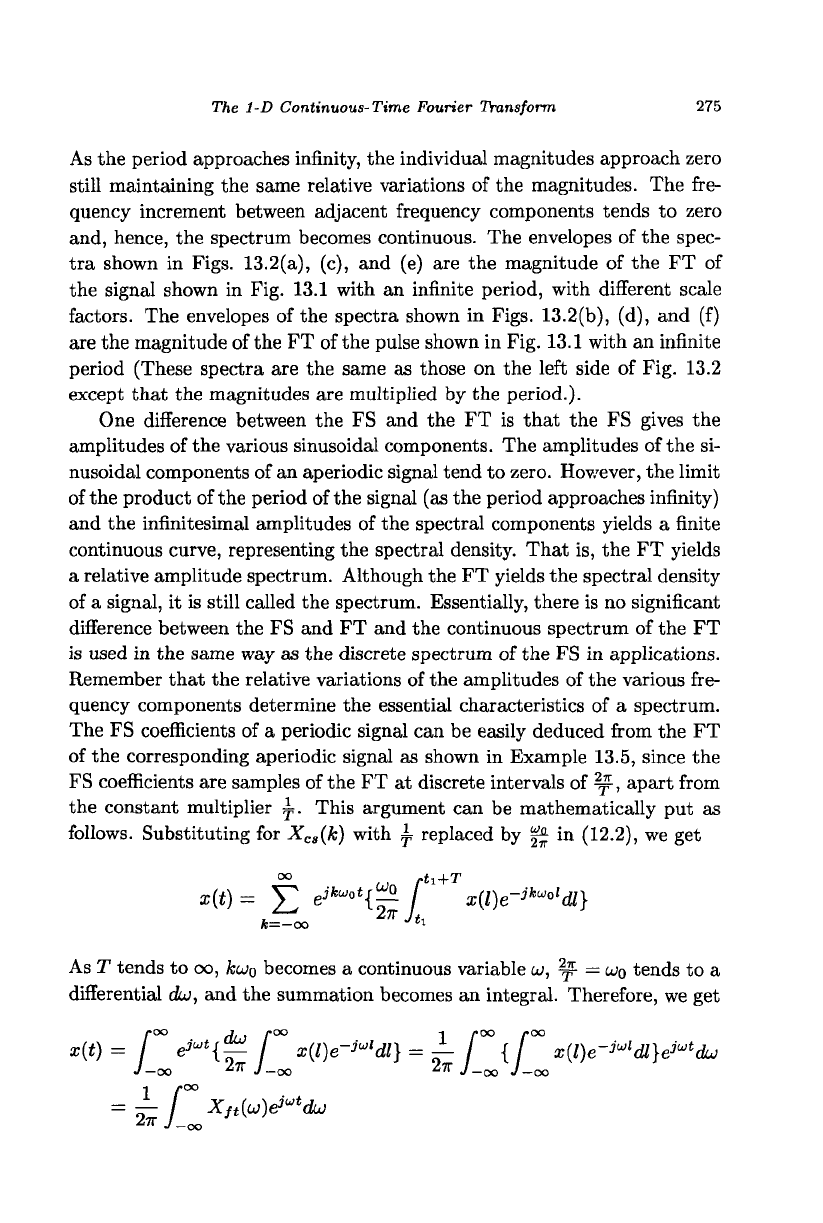
The 1-D
Continuous-Time Fourier Transform
275
As the period approaches infinity, the individual magnitudes approach zero
still maintaining the same relative variations of the magnitudes. The fre-
quency increment between adjacent frequency components tends to zero
and, hence, the spectrum becomes continuous. The envelopes of the spec-
tra shown in Figs. 13.2(a), (c), and (e) are the magnitude of the FT of
the signal shown in Fig. 13.1 with an infinite period, with different scale
factors. The envelopes of the spectra shown in Figs. 13.2(b), (d), and (f)
are the magnitude of the FT of the pulse shown in Fig. 13.1 with an infinite
period (These spectra are the same as those on the left side of Fig. 13.2
except that the magnitudes are multiplied by the period.).
One difference between the FS and the FT is that the FS gives the
amplitudes of the various sinusoidal components. The amplitudes of the si-
nusoidal components of an aperiodic signal tend to zero. However, the limit
of the product of the period of the signal (as the period approaches infinity)
and the infinitesimal amplitudes of the spectral components yields a finite
continuous curve, representing the spectral density. That is, the FT yields
a relative amplitude spectrum. Although the FT yields the spectral density
of a signal, it is still called the spectrum. Essentially, there is no significant
difference between the FS and FT and the continuous spectrum of the FT
is used in the same way as the discrete spectrum of the FS in applications.
Remember that the relative variations of the amplitudes of the various fre-
quency components determine the essential characteristics of a spectrum.
The FS coefficients of a periodic signal can be easily deduced from the FT
of the corresponding aperiodic signal as shown in Example 13.5, since the
FS coefficients are samples of the FT at discrete intervals of ^, apart from
the constant multiplier y. This argument can be mathematically put as
follows. Substituting for
X
cs
(k)
with ^ replaced by |£ in (12.2), we get
°° u
r
ti+T
;(t) = Y
e
J^ot{ o /
x
(l)e-
jkuol
dl}
t
™
2n
Jti
As T tends to oo,
kuiQ
becomes a continuous variable
LJ,
^ = wo tends to a
differential dw, and the summation becomes an integral. Therefore, we get
^{ir- / x{l)e-
iu,
dl] = £- / { / x(l)e-
jul
dl}e
jut
cLj
-oo
i7r
J-oo to J-oo J-oo
i r°°
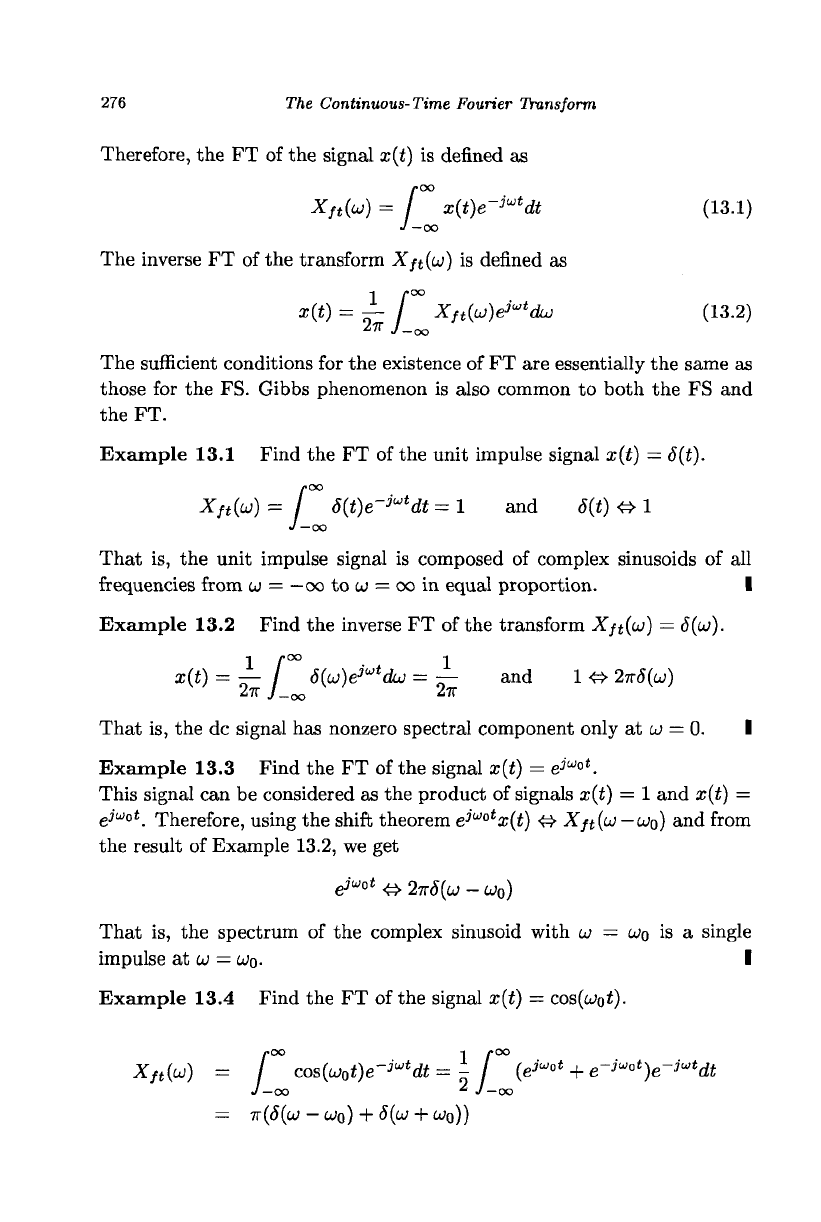
276
The Continuous-Time Fourier Transform
Therefore, the FT of the signal x(t) is defined as
/
oo
x(t)e-
jut
dt (13.1)
-oo
The inverse FT of the transform Xf
t
(u) is defined as
1 r°°
x(t) = — / Xf
t
(u)e?
ut
dw (13.2)
The sufficient conditions for the existence of FT are essentially the same as
those for the FS. Gibbs phenomenon is also common to both the FS and
the FT.
Example 13.1 Find the FT of the unit impulse signal x(i)
—
5{i).
/
oo
8{t)e-
jult
dt = 1 and 5{t) & 1
•oo
That is, the unit impulse signal is composed of complex sinusoids of all
frequencies from u — — oo to a; = oo in equal proportion. I
Example 13.2 Find the inverse FT of the transform Xf
t
(uj) = 8(UJ).
1 f°° 1
x(t) = — 6(oj)e
jut
dui = — and 1 O 2ir6(u)
2-K J_
O0
2n
That is, the dc signal has nonzero spectral component only at u = 0. I
Example 13.3 Find the FT of the signal x{t) = eP
Uot
.
This signal can be considered as the product of signals x{t) = 1 and x(t) =
e
jwot Therefore, using the shift theorem e^
mt
x(t)
<S>
Xft(u)—w
0
) and from
the result of Example 13.2, we get
e
iuot
«• 2-K6(UJ - u>
0
)
That is, the spectrum of the complex sinusoid with u =
u>o
is a single
impulse at u
—
UIQ.
I
Example 13.4 Find the FT of the signal x(t) =
COS(CJO^)-
/
OO I /-OO
cos{u
0
t)e-
jut
dt =- (e^
ot
+ e-
juJot
)e-i
ut
dt
-OO
2 ./-oo
— Tr(6(u! -
UIQ)
+ 6(iJ + W
0
))
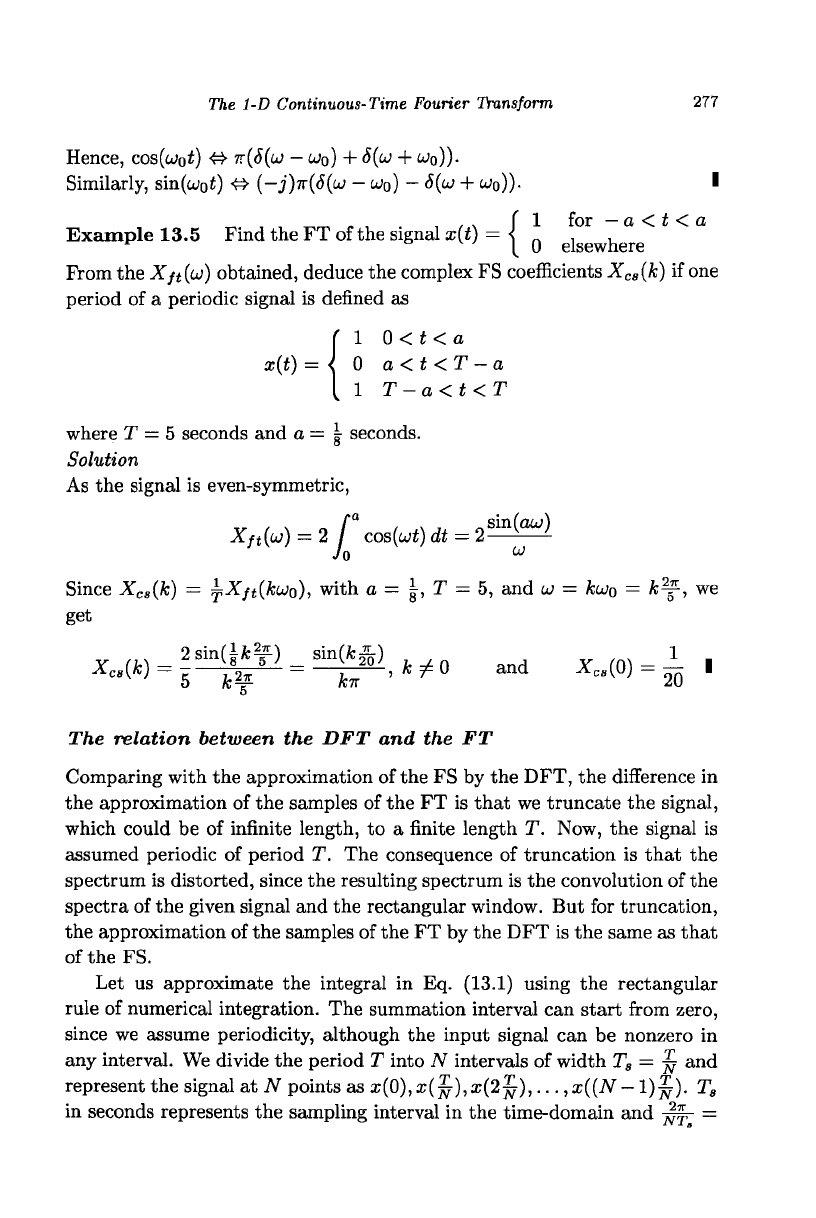
The 1-D Continuous-Time Fourier Transform
277
Hence, cos(ui
0
t) O ir(5(u - ui
0
) + S(u +
u>
0
))-
Similarly, sin(u;o*) 4* {-j)ir(6(u ~
w
o) -
&(w
+ wo))-
Example 13.5 Find the FT of the signal x(t) =
From the Xf
t
(u) obtained, deduce the complex FS coefficients
X
cs
(k)
if one
period of a periodic signal is defined as
{
1 0<t<a
0 a<t<T-a
1 T-a<t<T
where T = 5 seconds and a = | seconds.
Solution
As the signal is even-symmetric,
X
ft
(u)
= 2 / cos(wi) dt = 2—^—-
Jo
u
Since X
cg
(fc) = ^Xf
t
(kuJo), with a = |, T = 5, and w
get
^.« = I
Sl
^ = ^,M0 and
5
The relation between the DFT and the FT
Comparing with the approximation of the FS by the DFT, the difference in
the approximation of the samples of the FT is that we truncate the signal,
which could be of infinite length, to a finite length T. Now, the signal is
assumed periodic of period T. The consequence of truncation is that the
spectrum is distorted, since the resulting spectrum is the convolution of the
spectra of the given signal and the rectangular window. But for truncation,
the approximation of the samples of the FT by the DFT is the same as that
of the FS.
Let us approximate the integral in Eq. (13.1) using the rectangular
rule of numerical integration. The summation interval can start from zero,
since we assume periodicity, although the input signal can be nonzero in
any interval. We divide the period T into N intervals of width T
s
= jj and
represent the signal at N points as x(0),x(^-),x(2^),.. .,x((N-l)^). T
s
in seconds represents the sampling interval in the time-domain and -r£r =
J 1 for
—
a <t < a
1 0 elsewhere
koj
0
= k~, we
*»(0) =
Yo
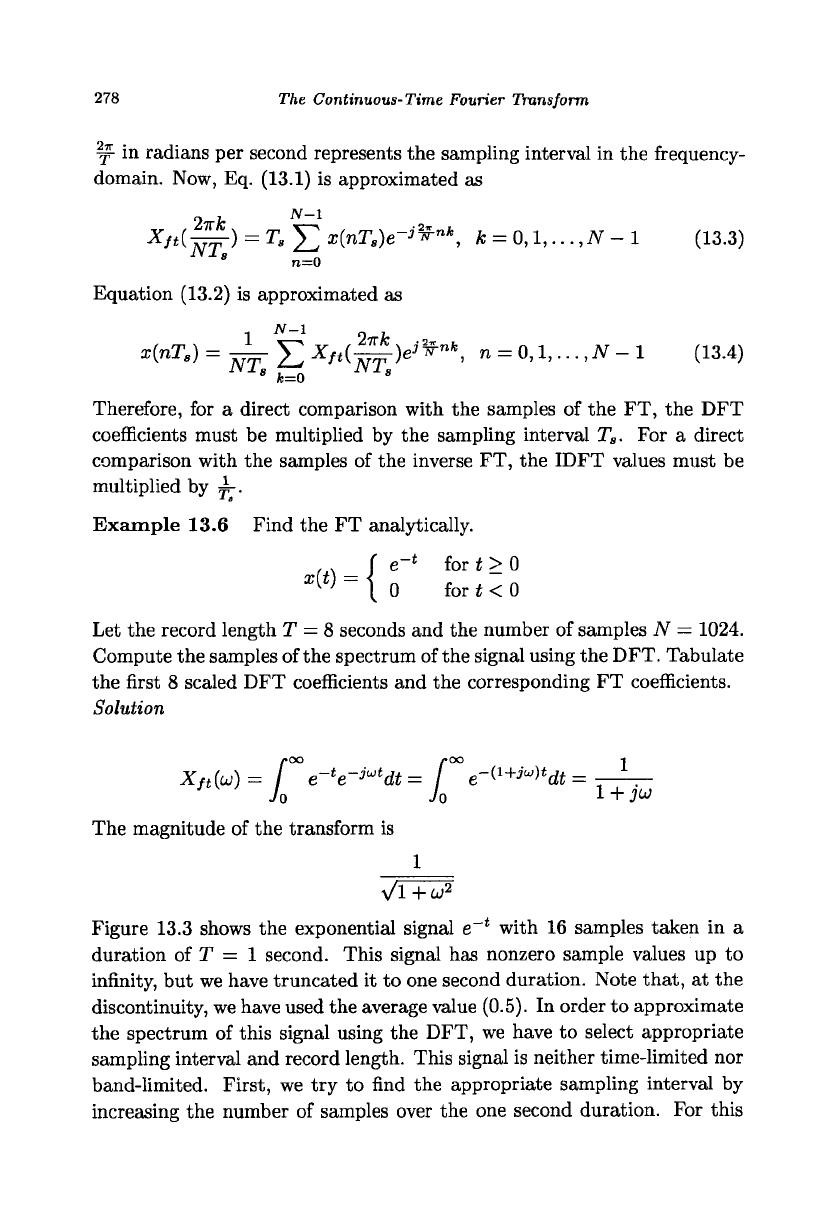
278
The Continuous-Time Fourier Transform
Y~ in radians per second represents the sampling interval in the frequency-
domain. Now, Eq. (13.1) is approximated as
2
*•
N
~
1
X
ft
(-£
T
r)
= T.Y
i
<nT
B
)e-i
3
B-
nh
1
k
=
0,1,..
.,N -
1 (13.3)
8
n=0
Equation (13.2)
is
approximated as
<nTs)
=
WF ^
X
Mj£fy
¥nk
> n
=
0,l,...,N-l
(13.4)
8
fc=o
s
Therefore,
for a
direct comparison with the samples
of
the FT, the DFT
coefficients must
be
multiplied by the sampling interval
T
s
.
For
a
direct
comparison with the samples of the inverse FT, the IDFT values must
be
multiplied by
£-.
Example 13.6 Find the FT analytically.
.
, fe"'
for
t > 0
x(t)
=
J
0 for *
< 0
Let the record length
T
—
8 seconds and the number of samples
N =
1024.
Compute the samples of the spectrum of the signal using the DFT. Tabulate
the first
8
scaled DFT coefficients and the corresponding FT coefficients.
Solution
/•OO
y-OO -I
X
ft
(w)=
e-*e->
ut
dt= e^
1+ju)t
dt=
-
Jo
Jo
1 +
JUJ
The magnitude of the transform
is
1
N/TT
w
Figure 13.3 shows the exponential signal
e
-t
with 16 samples taken
in a
duration
of T = 1
second. This signal has nonzero sample values
up to
infinity, but we have truncated
it
to one second duration. Note that, at the
discontinuity, we have used the average value (0.5). In order to approximate
the spectrum of this signal using the DFT, we have to select appropriate
sampling interval and record length. This signal is neither time-limited nor
band-limited. First, we try
to
find the appropriate sampling interval
by
increasing the number
of
samples over the one second duration. For this
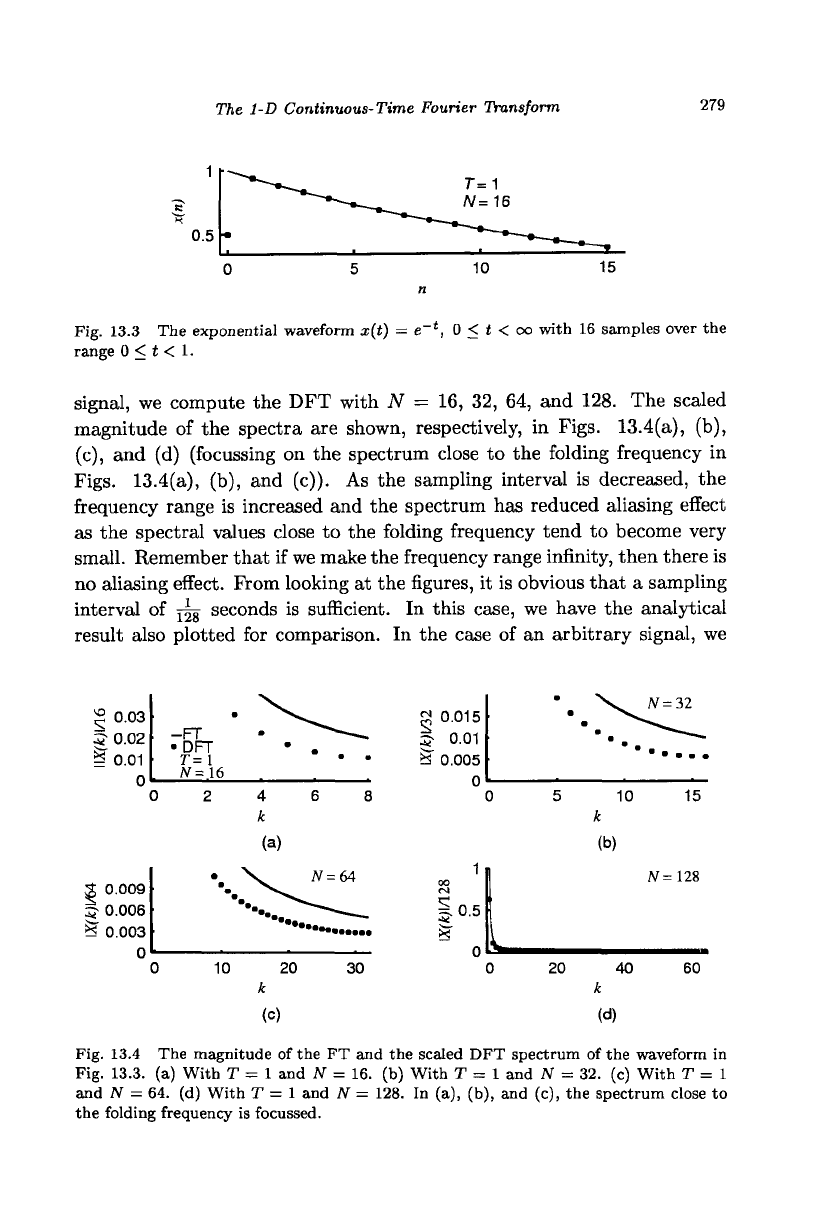
The 1-D Continuous-Time Fourier Transform
279
Fig. 13.3 The exponential waveform x(t) = e
_t
, 0 < t < oo with 16 samples over the
range 0 < t < 1.
signal, we compute the DFT with N = 16, 32, 64, and 128. The scaled
magnitude of the spectra are shown, respectively, in Figs. 13.4(a), (b),
(c),
and (d) (focussing on the spectrum close to the folding frequency in
Figs.
13.4(a), (b), and (c)). As the sampling interval is decreased, the
frequency range is increased and the spectrum has reduced aliasing effect
as the spectral values close to the folding frequency tend to become very
small. Remember that if we make the frequency range infinity, then there is
no aliasing effect. From looking at the figures, it is obvious that a sampling
interval of j^g seconds is sufficient. In this case, we have the analytical
result also plotted for comparison. In the case of an arbitrary signal, we
*2 0.03
5 0.02
&0.01
-FT
•DFT
T=\
W=16
3 0.009
5-
0.006
& 0.003
0
10 20
k
(c)
30
2 0.015
5; 0.01
S" 0.005
0
.0.5
X
/V = 32
5 10 15
k
(b)
W=128
20 40 60
k
(d)
Fig. 13.4 The magnitude of the FT and the scaled DFT spectrum of the waveform in
Fig. 13.3. (a) With T = 1 and N = 16. (b) With T = 1 and N = 32. (c) With T = 1
and N = 64. (d) With T = 1 and N = 128. In (a), (b), and (c), the spectrum close to
the folding frequency is focussed.
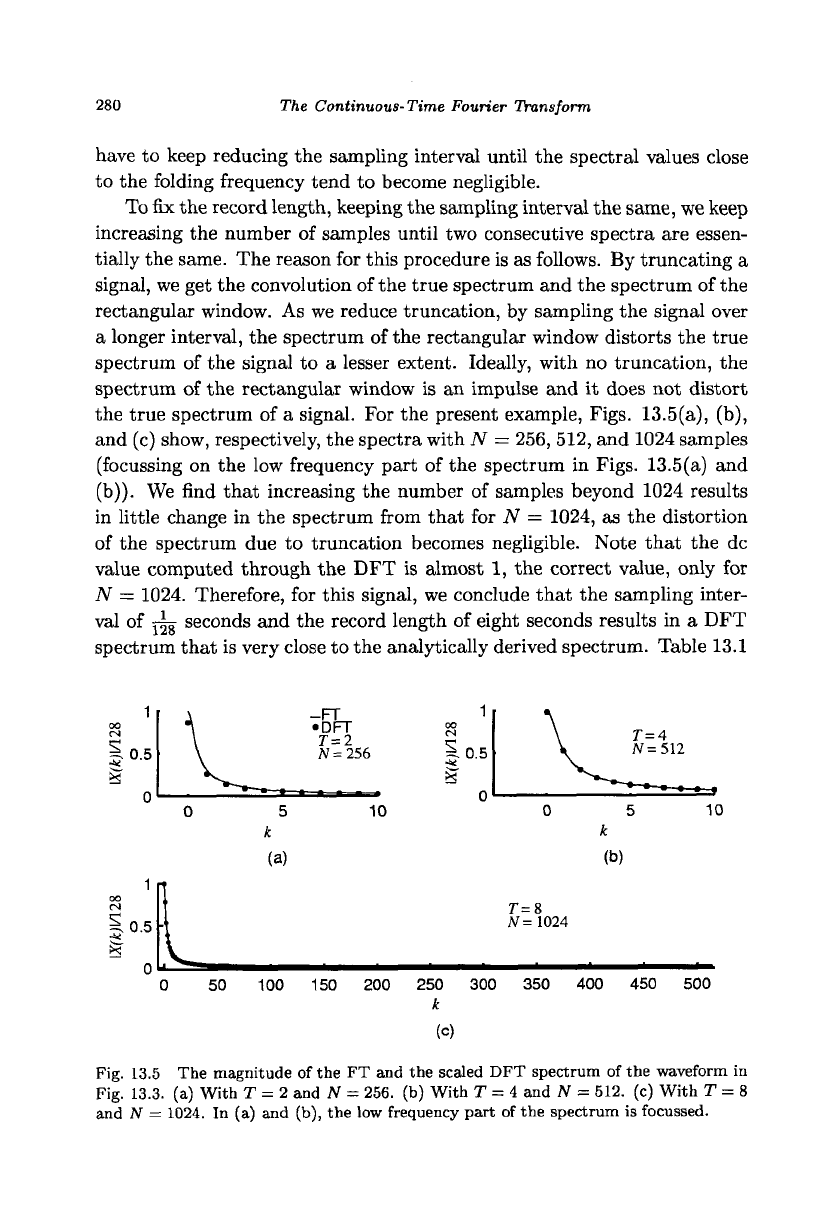
280
The Continuous-Time Fourier Transform
have to keep reducing the sampling interval until the spectral values close
to the folding frequency tend to become negligible.
To fix the record length, keeping the sampling interval the same, we keep
increasing the number of samples until two consecutive spectra are essen-
tially the same. The reason for this procedure is as follows. By truncating a
signal, we get the convolution of the true spectrum and the spectrum of the
rectangular window. As we reduce truncation, by sampling the signal over
a longer interval, the spectrum of the rectangular window distorts the true
spectrum of the signal to a lesser extent. Ideally, with no truncation, the
spectrum of the rectangular window is an impulse and it does not distort
the true spectrum of a signal. For the present example, Figs. 13.5(a), (b),
and (c) show, respectively, the spectra with N = 256, 512, and 1024 samples
(focussing on the low frequency part of the spectrum in Figs. 13.5(a) and
(b)).
We find that increasing the number of samples beyond 1024 results
in little change in the spectrum from that for N = 1024, as the distortion
of the spectrum due to truncation becomes negligible. Note that the dc
value computed through the DFT is almost 1, the correct value, only for
N = 1024. Therefore, for this signal, we conclude that the sampling inter-
val of j-|g seconds and the record length of eight seconds results in a DFT
spectrum that is very close to the analytically derived spectrum. Table 13.1
0.5
-FT
•DFT
T=2
N=256
10
0.5
T = 4
N
=
512
.0.5
r=8
N = 1024
(b)
50
100 150 200
250
k
300 350 400 450 500
(c)
Fig. 13.5 The magnitude of the FT and the scaled DFT spectrum of the waveform in
Fig. 13.3. (a) With T = 2 and N - 256. (b) With T = 4 and TV = 512. (c) With T = 8
and N = 1024. In (a) and (b), the low frequency part of the spectrum is focussed.
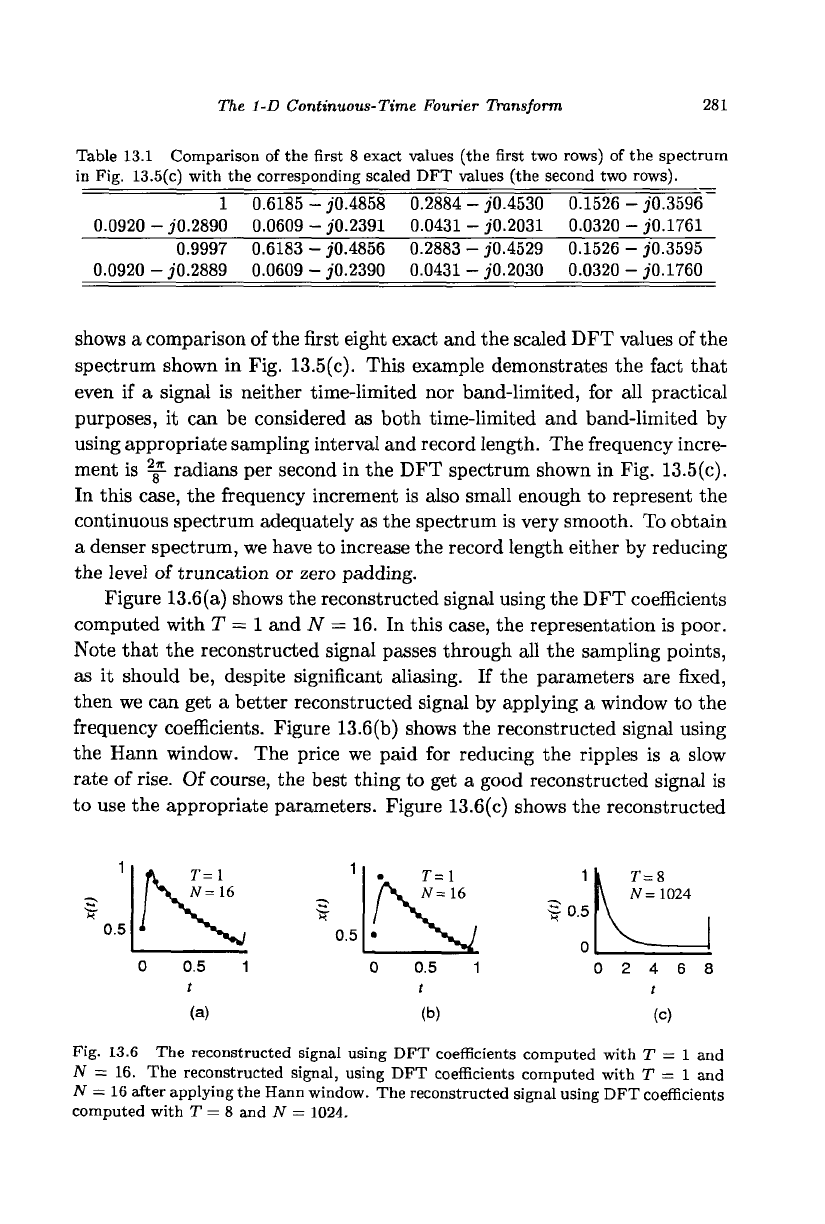
The 1-D Continuous-Time Fourier Transform
281
Table 13.1 Comparison of the first 8 exact values (the first two rows) of the spectrum
in Fig. 13.5(c) with the corresponding scaled DFT values (the second two rows).
0.0920 - jO.2890
0.6185-J0.4858
0.0609 - jO.2391
0.2884 - jO.4530
0.0431 - jO.2031
0.1526-jO.3596"
0.0320 -jO.1761
0.9997 0.6183 - jO.4856 0.2883-jO.4529 0.1526 - jO.3595
0.0920 - jO.2889 0.0609 - jO.2390 0.0431 - jO.2030 0.0320 - j'0.1760
shows a comparison of the first eight exact and the scaled DFT values of the
spectrum shown in Fig. 13.5(c). This example demonstrates the fact that
even if a signal is neither time-limited nor band-limited, for all practical
purposes, it can be considered as both time-limited and band-limited by
using appropriate sampling interval and record length. The frequency incre-
ment is ^2- radians per second in the DFT spectrum shown in Fig. 13.5(c).
In this case, the frequency increment is also small enough to represent the
continuous spectrum adequately as the spectrum is very smooth. To obtain
a denser spectrum, we have to increase the record length either by reducing
the level of truncation or zero padding.
Figure 13.6(a) shows the reconstructed signal using the DFT coefficients
computed with T = 1 and N = 16. In this case, the representation is poor.
Note that the reconstructed signal passes through all the sampling points,
as it should be, despite significant aliasing. If the parameters are fixed,
then we can get a better reconstructed signal by applying a window to the
frequency coefficients. Figure 13.6(b) shows the reconstructed signal using
the Hann window. The price we paid for reducing the ripples is a slow
rate of rise. Of course, the best thing to get a good reconstructed signal is
to use the appropriate parameters. Figure 13.6(c) shows the reconstructed
0.5
T=\
N=16
0.5
t
(a)
(b)
0 2 4 6 8
(c)
Fig. 13.6 The reconstructed signal using DFT coefficients computed with T = 1 and
N = 16. The reconstructed signal, using DFT coefficients computed with T = 1 and
N = 16 after applying the Hann window. The reconstructed signal using DFT coefficients
computed with T = 8 and N = 1024.
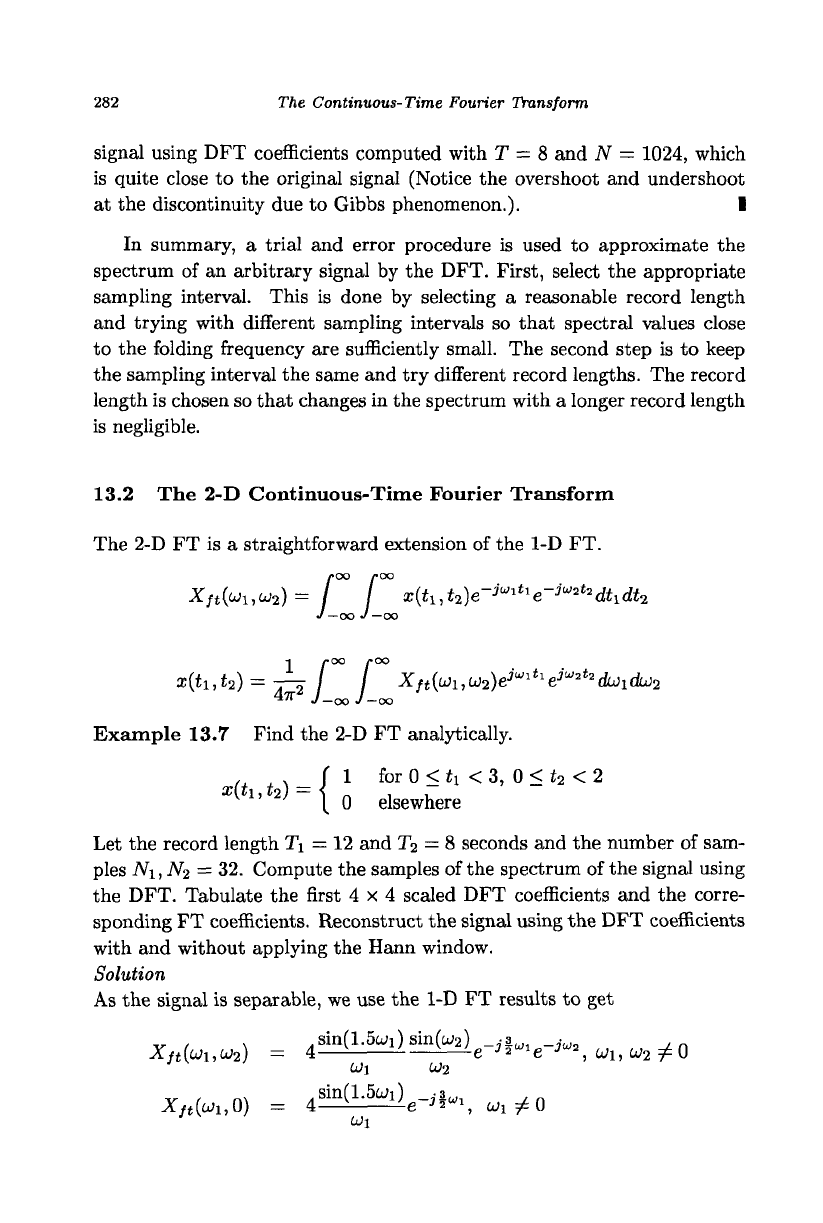
282
The Continuous-Time Fourier Transform
signal using DFT coefficients computed with T = 8 and N = 1024, which
is quite close to the original signal (Notice the overshoot and undershoot
at the discontinuity due to Gibbs phenomenon.). I
In summary, a trial and error procedure is used to approximate the
spectrum of an arbitrary signal by the DFT. First, select the appropriate
sampling interval. This is done by selecting a reasonable record length
and trying with different sampling intervals so that spectral values close
to the folding frequency are sufficiently small. The second step is to keep
the sampling interval the same and try different record lengths. The record
length is chosen so that changes in the spectrum with a longer record length
is negligible.
13.2 The 2-D Continuous-Time Fourier Transform
The 2-D FT is a straightforward extension of the 1-D FT.
/
oo roo
/ x(t
1
,t
2
)e-
ju
'
ltl
e-
j
"*
t
*dt
1
dt
2
-oo J—oo
-I rOO /"OO
x(ti,t
3
) =
T1
/ ^(wi.waJe^V^dwidwa
^™ J—oo J—oo
Example 13.7 Find the 2-D FT analytically.
{I
u ^ _ J - for 0 < ii < 3, 0 < i
2
< 2
*(*i.'
2
)-<{ n
e
i
S
e
W
here
Let the record length Ti = 12 and T
2
= 8 seconds and the number of sam-
ples
Ni,N
2
= 32. Compute the samples of the spectrum of the signal using
the DFT. Tabulate the first 4x4 scaled DFT coefficients and the corre-
sponding FT coefficients. Reconstruct the signal using the DFT coefficients
with and without applying the Hann window.
Solution
As the signal is separable, we use the 1-D FT results to get
v
i \ sin(1.5wi)sin(w
2
) _,-a
wl
_,-
W2
,
n
X
ft
(u!i,u
2
)
= 4—i '-—^—-e
J
^
l
e
JW2
, wi, ui
2
^0
U)\
Ul
2
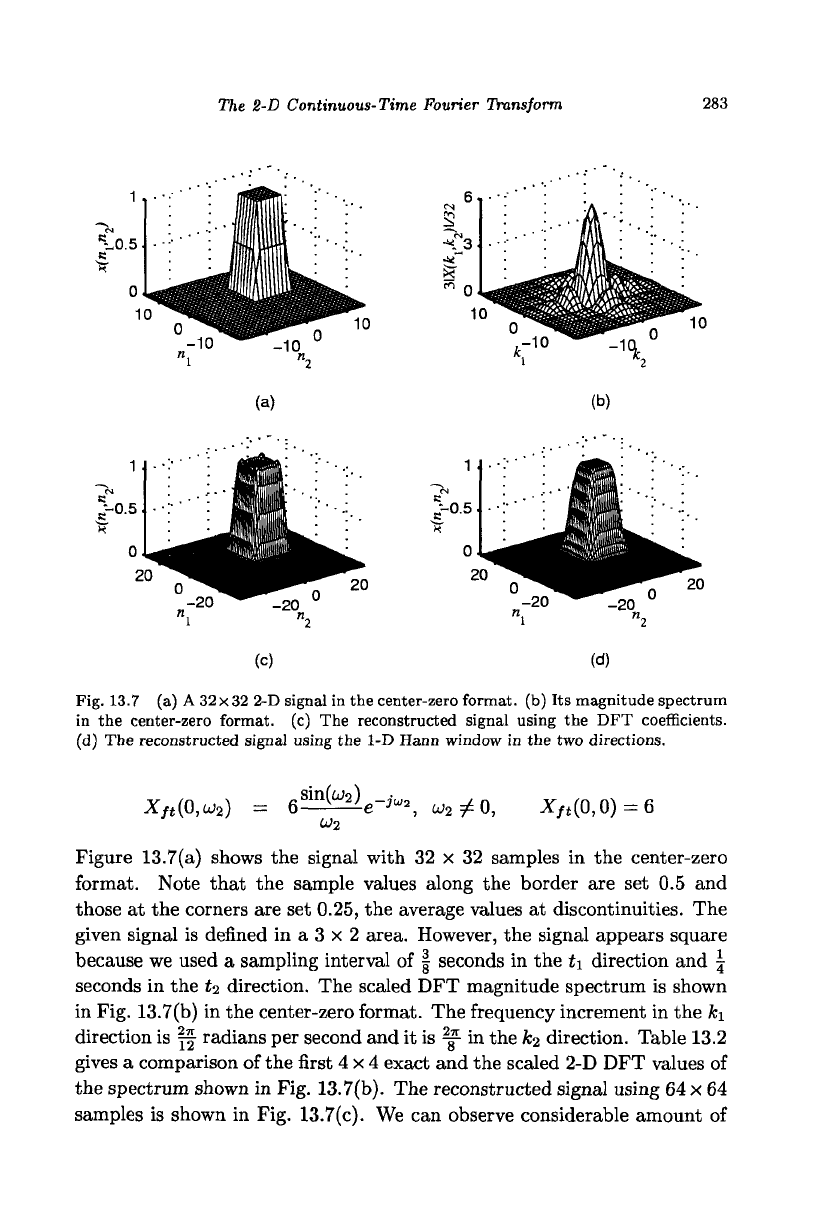
The 2-D Continuous-Time Fourier Transform
283
(a)
(b)
,-0.5
Z-0.5
(c)
(d)
Fig. 13.7 (a) A
32
x
32
2-D signal in the center-zero format, (b) Its magnitude spectrum
in the center-zero format, (c) The reconstructed signal using the DFT coefficients.
(d) The reconstructed signal using the 1-D Hann window in the two directions.
X
ft
(0,uj
2
)
= 6^)e-'-, a* # 0,
W2
Xf
t
(0,0) = 6
Figure 13.7(a) shows the signal with 32 x 32 samples in the center-zero
format. Note that the sample values along the border are set 0.5 and
those at the corners are set 0.25, the average values at discontinuities. The
given signal is defined in a 3 x 2 area. However, the signal appears square
because we used a sampling interval of | seconds in the t\ direction and \
seconds in the £
2
direction. The scaled DFT magnitude spectrum is shown
in Fig. 13.7(b) in the center-zero format. The frequency increment in the fci
direction is ff radians per second and it is ^ in the fc
2
direction. Table 13.2
gives a comparison of the first 4x4 exact and the scaled 2-D DFT values of
the spectrum shown in Fig. 13.7(b). The reconstructed signal using 64 x 64
samples is shown in Fig. 13.7(c). We can observe considerable amount of
